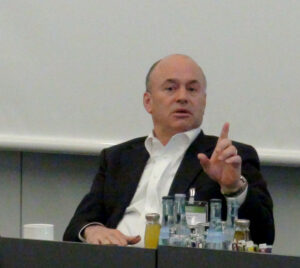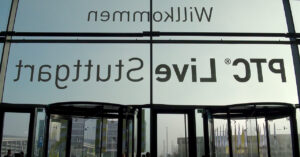PTC Live went on the road in Europe at the end of 2013. The message? PTC expects the strongest growth in 2014 to come from Europe. The company has identified 7 forces affecting its markets and its customers and it outlines how is focus on these 7 forces will accelerate the company’s growth.
By Tom Lansford
The European market represents 37% of PTC’s FY 2013 revenue putting Europe on par with the Americas. On successive weeks in the last quarter of 2013, PTC executives joined customers and partners in Germany at the Stuttgart ICS convention center and in France at Eurosites George V just steps from the Champs-Élysées.
The PTC message to the market remains consistent and the presentations in Europe follow the same script as PTC Live in the U.S. held in the summer of 2013. The big difference is that PTC focused on its European customers and took a European perspective on the way market forces are playing out. PTC identifies 7 forces — digitization, globalization, regulation, personalization, servitization, software intensive products, and connectivity — which are causing customers to radically change their business practices. At PTC Live, the company outlined strategies to deliver solutions which allow customers to react to these forces, and to adapt their business to take advantage of these forces in the market.
PTC execs say the conversation they have crafted is based on careful observation of market realities. That they’re committed to this vision is evidenced by the company’s acquisition and development of technologies and products which address each force. The latest being the acquisition of ThingWorx at the end of December.
PTC targets 7 forces
The first of the seven forces is digitization. This ‘force’ has been with us for some time and PTC helped kick off the evolution to digitization many, many years ago. It goes beyond designing in 3D. It goes to the point where every aspect of a product is contained in digital format, the DNA of the product. It eliminates the drawing-to-hard prototype iterative loop. Today, companies are moving towards fully digital designs and enabling virtual prototyping.
Once information is digitized, it becomes highly portable. And this enables the second force: globalization. Geographic limitations are no longer issues for companies who adapt to this force. PTC, and its competitors in the CAD industries, see innovation being born out of a multi-national, global, multi-cultural process. PTC says its Windchill Enterprise solution delivers a single-source of design “truth” in a widely distributed product design and development environment and enables companies to leverage the power of this force.

Personalization is the fourth force. In areas not normally considered mass-customization, such as heavy trucks, companies are finding the force of personalization to be a significant challenge. The challenge is to balance product variability with economies of scale.
The fifth force is the unstoppable move towards software intensive products. This force drove PTC to purchase MKS and the Integrity software management product a few years ago.
PTC describes the sixth force as servitization, a term that describes the shift to selling the utility of the product rather than the product itself. There is satisfaction in owning something, but this comes with overhead, too. Many companies and consumers are beginning to purchase the utility of a device rather than the product and companies are seeing ways to better automate support and service systems. PTC has differentiated their solutions from traditional competitors with their offerings in Service-Lifecycle-Management, or SLM.
Companies can service products better and develop better products when they can see what is happening to the product in the field which brings us to the seventh and final force. The trend in manufacturing toward developing and deploying smart, connected products is coming and is unstoppable. This concept is often synonymous with ‘the internet of things’ or IoT. The Internet of Things will transform completely the way that companies design and service products. Smart, connected devices have the potential to increase efficiencies and reduce costs by providing real world data about how products are actually used and how they function.
Europe will drive PTC business in 2014
CEO James Heppelmann was able to talk with me in Stuttgart about PTC’s business results for the last few years and their prospects for 2014. After the financial crisis, fiscal year 2011 — October 2010 to September 2011 — was a strong growth year for the company. Only in the second half of their 2012 and the first half of 2013 did the company see business slow down around the globe. Different regions slowed for different reasons. The end of PTC’s fiscal 2013 reporting year saw an improvement to the business situation for PTC across all regions. In 2014, Heppelmann expects Europe to be the most significant contributor to PTC’s business results — provided the current economic progress continues as the company expects.
Heppelmann also discussed PTC’s cloud strategy in the interview. He stated that different parts of PTC’s global strategy will be influenced by the cloud at different points in time, referring to it as a “partly-cloudy strategy.” PTC has acquired NetIdeas which allows PTC to offer private-hosting to customers. It keeps every customer’s system running in a private instance and does not use a multi-tenant, which Heppelman said, can lead to questions regarding security of the company’s information. Later, if a customer wants, PTC is able to give that system back to the customer.
PTC locks-down the “seven forces” strategy with ThingWorx
Six weeks after PTC Live in Stuttgart, PTC announced the acquisition of ThingWorx. PTC has been working on technology & solutions which would deliver compelling value for the IoT. Then they found that ThingWorx has a platform which paralleled the PTC R&D projects. ThingWorx technologies would allow PTC to gain years in development time and come to market much faster. Just before 2013 came to a close, the company announced the acquisition of ThingWorx.
PTC paid $112 million to acquire ThingWorx. The acquisition advances PTC’s time-to-market several years and positions the company to offer solution platforms immediately and to integrate connectivity into PTC products much sooner.
The purchase fits neatly into PTC’s public strategy. It is easy to see that the seventh force discussed by PTC — smart, connected devices, ie; the Internet of Things — is the only market force for which PTC could not offer a solution which delivers clear, obvious benefits.
One analyst calls it a “big bet” and a “huge move,” but given the PTC seven forces perspective and their intimate relationships with their manufacturing customers, it strikes me as a natural fit and logical next step. Some point to Autodesk’s and Google’s recent acquisitions at evidence that PTC’s bet is likely to pay-off. I see it as self-evident. A world of connected, smart devices is coming — there is absolutely no question about that. Consider, for example, that every Whirlpool product is designed to be connected to the internet … today.
The obvious need is to build the infrastructure for the Internet of Things which does not yet exist. ThingWorx is a platform to do exactly that. PTC is able to sell the platform to existing PTC target customers and to ThingWorx customers who are not traditional PTC customers.
Later, when this technology is built into PTC’s PLM and SLM platforms, the company will offer very valuable and highly-differentiated solutions to manufacturing customers. This is the last of the seven forces for which PTC needed a valuable solution. My guess is that PTC management viewed this acquisition as an obvious extension of their Product & Service Advantage strategy.
The European Picture
Michael Sauter, Senior Vice-president is responsible for business in the German-speaking countries said PTC’s results in Germany were good in the last fiscal year. And, in fact, the company’s annual report for 2013 calls out the importance of Europe to PTC’s business saying, “we are optimistic about the longterm outlook in … Europe, where we had solid growth in license revenue in the fourth quarter of 2013, compared to the fourth quarter of 2012 …” Sauter says the company has won new customers and he says, they have successfully placed new solutions from acquisitions into the market.
PTC invested significant resources into PTC Live events in Europe. Executive management invested their time in the events spending time with customers, partners, and press. European manufacturing companies are among the most often cited examples of innovative corporations taking on the challenges of the seven forces. And the European region will likely be the most significant contributor to PTC’s business this year. Keep an eye on Europe in 2014.
Tom Lansford has been working in the professional graphics market for more than 25 years. CADplace provides information on the CAD and professional design market In German, French and English. Visit www.cadplace.co.uk, www.cadplace.fr, and www.cadplace.de






